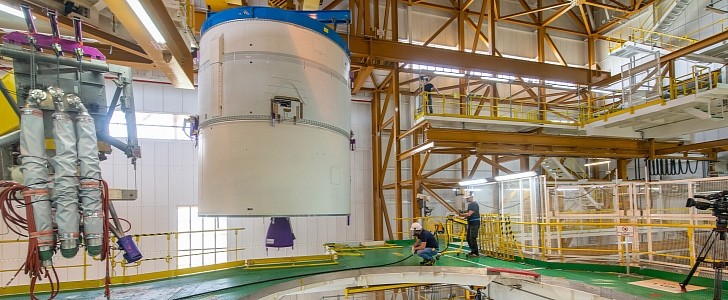An Ariane 5 was recently stacked at Europe's Spaceport in French Guiana, and it's currently undergoing final preparations to receive the massive James Webb Space Telescope. Once integrated with the telescope, the Ariane 5 will send Webb on its ultimate space journey.
On November 11th, the rocket's upper stage arrived at the launch vehicle integration facility in French Guiana, where it was joined by the core stage and boosters. It was then raised into the vertical position and mated with the top of the core stage.
Powered by an HM7B engine, the Ariane 5 upper stage will carry around 15 tons (14 metric tons) of liquid oxygen and liquid hydrogen propellant to deliver enough force to leave our skies with the giant telescope. Once it separates from the core stage, the upper stage will send the telescope on its million-mile (1.5 million-kilometer) journey away from Earth.
Webb will be the world's largest and most powerful space telescope. The European Space Agency (ESA) is providing the telescope's launch vehicle as part of an international cooperative agreement. For this mission, ESA managed the Ariane 5 adaptations in collaboration with industry partners.
To fit into the rocket, the telescope must fold its 6,5 meters (21 ft) mirror, which will then be commanded to unfold as it reaches its destination in space (precisely, the second Lagrange point or four times the distance to the Moon).
Webb arrived in French Guiana in October after a 16-day voyage at sea. Preparations have already begun for the telescope's big journey, and soon, it will join the rocket for integration.
On December 18th, the giant observatory will leave Earth and will travel for about a month. Once deployed, Webb will help scientists peer into all phases of cosmic history and study how galaxies and planets were formed, searching for evidence of possibly habitable alien worlds.
Powered by an HM7B engine, the Ariane 5 upper stage will carry around 15 tons (14 metric tons) of liquid oxygen and liquid hydrogen propellant to deliver enough force to leave our skies with the giant telescope. Once it separates from the core stage, the upper stage will send the telescope on its million-mile (1.5 million-kilometer) journey away from Earth.
Webb will be the world's largest and most powerful space telescope. The European Space Agency (ESA) is providing the telescope's launch vehicle as part of an international cooperative agreement. For this mission, ESA managed the Ariane 5 adaptations in collaboration with industry partners.
To fit into the rocket, the telescope must fold its 6,5 meters (21 ft) mirror, which will then be commanded to unfold as it reaches its destination in space (precisely, the second Lagrange point or four times the distance to the Moon).
Webb arrived in French Guiana in October after a 16-day voyage at sea. Preparations have already begun for the telescope's big journey, and soon, it will join the rocket for integration.
On December 18th, the giant observatory will leave Earth and will travel for about a month. Once deployed, Webb will help scientists peer into all phases of cosmic history and study how galaxies and planets were formed, searching for evidence of possibly habitable alien worlds.






